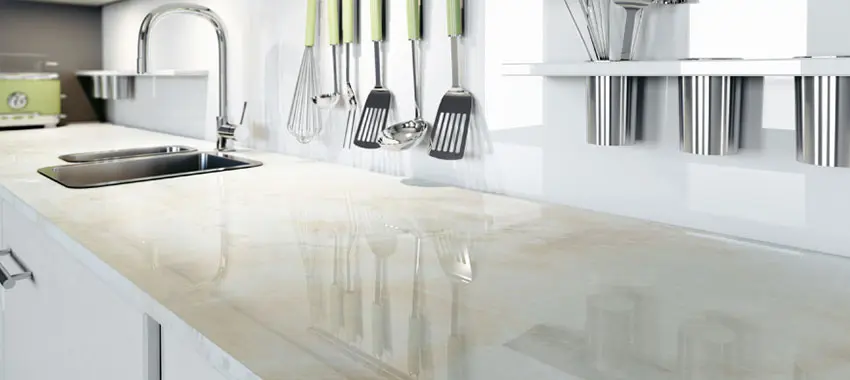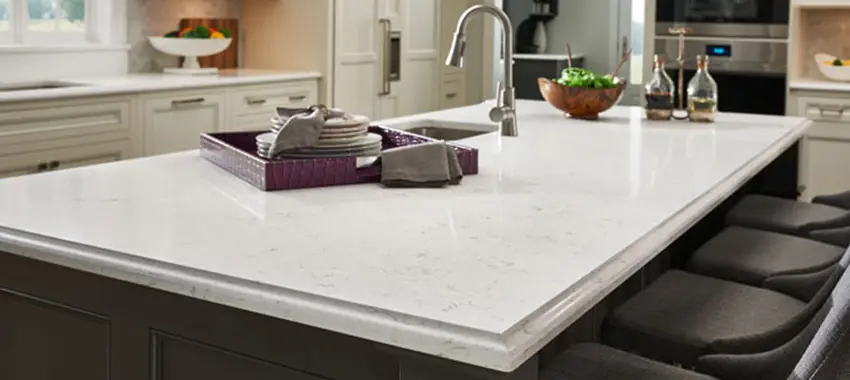Aug
Quartz Vs. Porcelain Countertops: Which One Would Win?
- 2024
- FlintStoneTops
Choosing countertops can be a hassle, especially if you’re confused between two materials. Well, if you’re stumped between porcelain and quartz kitchen countertops, then you need to go through this guide.
The Differences Between Quartz And Porcelain Countertops
Durability
One of the most important things to consider when choosing a countertop material is durability and strength. If a countertop is strong and durable, then it will last for years to come preventing frequent repairs, which can cost a lot in the long run.
Quartz Countertops
Quartz is one of the most durable man-made materials out there. It is a material that is scratch-resistant, doesn’t chip or break and it’s also an amazing alternative to granite if your budget doesn’t allow granite. There are just so many qualities of quartz when it comes to strength and it is truly one of the best materials you can invest your money in because they will last for a long time.
Porcelain Countertops
As far as porcelain is concerned, it is also a reasonable material with decent strength, but it’s no way near in strength to quartz. It can chip and crack easily, especially if you put too much force on it and the edges are the most fragile part of this material.
Nonetheless, it’s still an amazing pick if you want something that will look amazing in the kitchen because porcelain is one of the most beautiful materials out there.
Appearance
Speaking of beauty, the beauty and appearance of a material is also a key selling point when it comes to countertops. This is why appearance also plays a huge role in determining the popularity of a material.
Quartz Countertops
Quartz is a beautiful material, so much so, that it looks like the tougher cousin of marble. The light color with washes of dark and subtle veining on the surface is to die for.
It’s made out of silica, pulverized rocks, and compacted together under high temperature and pressure to bring forth a work of art. So, you can expect a wide range of colors and patterns. Many of them are truly a treat for the eyes.
Porcelain Countertops
Porcelain is even more beautiful than quartz. It has a shiny surface that glistens when the light hits just right and it’s a material that will leave people in awe. It is a material that is light in color, but the very ethereal balance of beauty and durability makes porcelain such a wonderful choice in kitchens and bathrooms. It’s a material that will make everyone ask about it, but it’s also not as fragile as marble and other softer materials.
Maintenance
Maintenance is a key factor to consider when you’re choosing from an array of countertop materials. The material needs to be easy to clean and maintain.
Quartz Countertops
Quartz will never disappoint you in the maintenance department. It’s a material that’s perfect for anyone who doesn’t want to slave over their countertops all day. It can be cleaned with a simple water and detergent solution. It doesn’t need to be sealed, and it can go on for years without getting polished. So, you’re in for a treat.
Now, quartz is easy to clean, but a drawback is that because of its light color, you will need to clean it every single day because light colors will show stains very prominently.
Porcelain Countertops
Porcelain is also an easy material to clean. It is naturally water resistant, so it’s perfect for use in the kitchens and bathrooms, just like quartz, and it can be cleaned with simple detergent solutions too.
If you get a glossy countertop finish, then you’ll need to have it polished every year or so, depending on the longevity of the sheen, but that’s pretty much it for maintaining this beautiful and robust material.
Price
Price is another crucial factor that most people keep in mind.
As for quartz, the prices are quite high. They can range anywhere from $45 to $200. On the other hand, porcelain countertops’ price range is between $55 to $120. So, people might think that porcelain is much cheaper than quartz, but the price will vary, based on the finish, the size of the slabs, and where you want to get them installed.
Sometimes, for smaller kitchens, quartz can run a bit cheaper than porcelain, so it all depends on preference at the end of the day.
Finishing Options
Finishing of the countertops is also important, because it the finish completes the look for the countertop or island.
Quartz Countertops
For quartz, the finishing options are quite a bit. You can get quartz in a honed finish, a glossy finish, and even in leathered finish. Now, what’s the difference between all of these finishes? Well, honed quartz is a matte quartz with a non-shiny finish. It is amazing for people who don’t fancy polished quartz.
Polished or glossy quartz has a mirror-like finish and it’s very shiny; perfect for places with no natural sunlight because it bounces off light from the fixtures and makes the kitchen look spacious.
As for a leathered finish, it’s in the middle. It has a slight sheen on the surface which kind of looks matte in certain lights and shiny in others, so it’s perfect if you can’t choose between shiny or matte and want a little bit of both.
Porcelain Countertops
There are only two finishes available for porcelain countertops. The first is a matte finish that doesn’t reflect light and the second one is a high gloss glaze. In porcelain, the finish is done after installation, as compared to other countertops, in which the finish is brought by the sealant.
Heat Resistance
Another important factor to consider when you’re going for a countertop material is heat resistance. Since you’ll be working in the kitchen, you need to know about the heat resistance of each material because heat can damage the countertops to no end and if you’re someone who works with a lot of hot pots and pans in the kitchen, then you need a material that is going to withstand everything.
Quartz Countertops
Quartz countertops are extremely durable, but they don’t resist heat well. Anything above 150 degrees Fahrenheit can stain the quartz surface. You can use the countertops as a surface where you can put hot foods, but over time, it’s going to lead to black stains and that’s not what you want at all. These stains are a nightmare to remove and they will be permanent. So, you should use trivets and coasters.
Porcelain Countertops
Porcelain countertops perform really well under high heat. These countertops may look fragile but they are a beast against heat as they can withstand heat more than 1,200 degrees Fahrenheit. They repel heat from hot foods and prevent the countertops from getting stained.
So, even though porcelain is a light-colored material, it won’t be dotted with those weird and very permanent black splotches all over the surface.
This is amazing considering that porcelain isn’t even a material that’s popular for kitchens. Since it’s mostly used in bathrooms and as flooring and wall cladding, this property of porcelain is overshadowed. But it’s good to know that this material can take hot temperatures like a pro.
Conclusion
Quartz and porcelain are both amazing and they also have a couple of drawbacks of their own. So, this guide will help you choose a material that’s right for your kitchen. If you want to see some colors and patterns, contact quartz countertop dealers Rockville.



